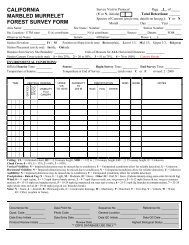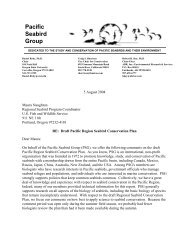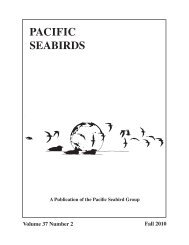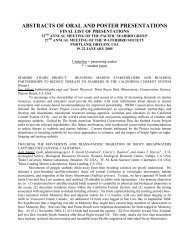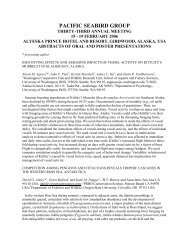PSG 2012 Hawaii abstracts - Pacific Seabird Group
PSG 2012 Hawaii abstracts - Pacific Seabird Group
PSG 2012 Hawaii abstracts - Pacific Seabird Group
You also want an ePaper? Increase the reach of your titles
YUMPU automatically turns print PDFs into web optimized ePapers that Google loves.
ehaviors and associations, diet, dive depths) of the world’s seabirds. A recent attempt to apply these<br />
protocols to seabirds breeding on the French administered Îles Éparses (The Scattered Islands), western<br />
Indian Ocean, revealed several life history characteristics of tropical seabirds that present challenges to<br />
implementing these protocols. In particular, the relaxed breeding (e.g. bi-annual, year<br />
round/opportunistic) and subsurface facilitated foraging behaviors of many tropical seabirds create unique<br />
challenges when attempting to identify and delineate important marine areas for protection. Recent<br />
advances in tagging technology have produced high quality data for some species, but rarely cover more<br />
than a couple of seasons and have seldom been overlaid with high quality movement data of subsurface<br />
predators in order to identify key foraging areas. Multi-season tracking efforts, tracking of smaller species<br />
and the integration of data on seasonal and localized movements of subsurface predators will help to<br />
address these knowledge gaps. However, the designation and protection of important marine habitats and<br />
areas for tropical seabirds may require managers to develop different protection criteria than those<br />
commonly employed for temperate species.<br />
DEEP DIVING DOVEKIES IN THE WARMING GREENLAND SEA<br />
Nina Karnovsky* 1 , Zachary Brown 2 , Jorg Welcker 3 , Ann Harding 4 , Wojciech Walkusz 5 , David Grémillet 6 ,<br />
Alexander Kitaysky 7 , 1 Pomona College, Dept. of Biology, 175 W. 6 th St. Claremont, CA 91711,<br />
nina.karnovsky@pomona.edu; 2 Stanford University, Department of Environmental Earth System Science,<br />
Stanford, CA 94305, USA; 3 Norwegian Polar Institute, Tromso, Norway; 4 Alaska <strong>Pacific</strong> University,<br />
Environmental Science Department, Anchorage, Alaska, 99508, USA; 5 Institute of Oceanology, PAS,<br />
Marine Ecology Department, Sopot, Poland; 6 Centre National de la Recherche Scientifique, CEFE, F-<br />
34293 Montpellier, Cedex 5, France; 7 Institute of Arctic Biology, Department of Biology and Wildlife,<br />
University of Alaska, Fairbanks, AK, 99775, USA<br />
The Atlantic sector of the Arctic is undergoing widespread climate change with increases in air and sea<br />
temperatures which impact the timing of ice retreat, snow melt and the development of the marine food<br />
web. We hypothesized that in the Greenland Sea, dovekies (Alle alle) breeding adjacent to water masses<br />
with smaller, less energy-rich prey, work harder to find food and have higher stress levels. We tested this<br />
hypothesis by attaching time-depth recorders to provisioning dovekies at three colonies adjacent to<br />
different water masses (the West Spitsbergen Current with the smallest prey, the East Greenland Current<br />
with the most lipid rich prey, and the Sorkapp Current which has a medium sized copepod). We<br />
determined the length of time dovekies at different colonies spent at-sea collecting food for themselves<br />
and their chicks. We also measured circulating corticosteroid hormone levels in their blood to assess<br />
stress levels. We collected chick meals to determine the energetic content of prey fed chicks at the<br />
different colonies. We found that dovekies are sensitive to the quality of prey available to them. Dovekies<br />
exposed to less profitable prey made longer foraging trips and worked harder while at-sea to collect prey<br />
for themselves and their chicks. We use this inter-colony comparison of dovekie foraging behavior as a<br />
model to understand how continued warming in the Greenland Sea may influence this species. Future<br />
declines in dovekies may impact terrestrial Arctic food webs which are highly influenced by the annual<br />
input of nitrogen-rich dovekie guano on the tundra.



